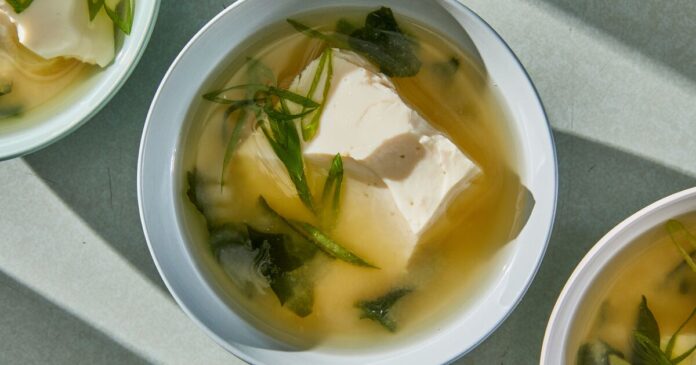
This recipe ran under the headline “How to Make the Best Miso Soup of Your Life.”
It’s inspired by the version at Benkay in Portland, Maine, where chef Seiji Ando uses extra katsuobushi (bonito flakes) in his broth. (He also adds a bit of sake and mirin.)
What results is simple and complex, and truly restorative.
Miso Soup
Makes 4 servings
1 (5-inch) square kombu (dried kelp)
1 tablespoon sake
1 tablespoon mirin
5 grams wakame (dried seaweed), crushed (¼ cup)
2 cups loosely packed katsuobushi (often labeled “bonito flakes”)
1 (14-ounce) package silken tofu, drained
¼ cup miso (white or red; see Tip), plus more to taste
1 large scallion, thinly sliced
Make dashi, the soup base, by soaking kombu in 4 cups cold water for 15 minutes in a medium pot. Add the sake and mirin and bring to a simmer over high heat. As soon as the water starts to boil, take the pot off the heat, cover and let the kombu steep until the liquid smells like the sea, about 15 minutes.
Meanwhile, in a small bowl, soak the wakame in about 3 inches of cold water until soft, about 15 minutes as well. Drain and set aside.
When ready to serve, remove the kombu from the pot (see Tip). Stir the katsuobushi into the kombu broth, cover and let steep for 1 minute. Strain into a medium bowl, pressing down on the katsuobushi to extract all of the liquid; discard the spent flakes. This is your dashi.
Return the dashi to the pot and add the drained wakame. Scoop the tofu into the pot using a spoon or your hand, leaving it in large chunks. Bring the soup to a boil, then remove from the heat.
Add the miso to a small bowl, then ladle over some of the broth and stir to dissolve. Add the dissolved miso to the pot and gently stir until incorporated. Add the scallion, taste for seasoning (adding more miso if you’d like) and serve immediately.
Tips: White, or shiro, miso is made with a higher proportion of rice, which lends a milder, sweeter flavor, whereas red, or aka, miso, is made with more soybeans, resulting in a bolder, more umami-rich taste and a darker color as well.
You can discard the simmered kombu or thinly slice it into strips and add to pastas, soups, stews and salads for added vegetal heft.
Kim writes for The New York Times.



